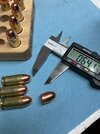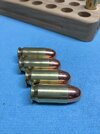GeoDudeFlorida
Member
- Joined
- Dec 1, 2020
- Messages
- 11,265
That’s why I say give-or-take a tenth or two. I have a “4.9gr of Bullseye” dipper. It’s a modified 0.5CC and I can change my angle of pull to get a higher or lower load pretty easily. Practice.I use the .5 dipper and have noticed same basic volume thing.
But I do still weigh each throw, just as a double check. And to test my eye/hand every once in a while. I’m not bothered by +/- 0.1gr of Bullseye. I can’t shoot the difference between 4.8 and 5.0gr and my chronograph can’t tell one from the other either. I keep trying to fool the little bugger but it just won’t play along.



